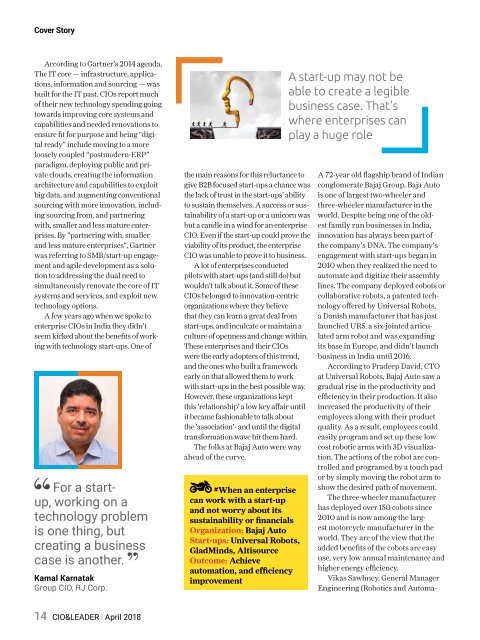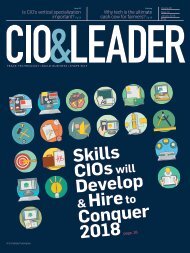CIO & LEADER-Issue-01-April 2018 (1)
You also want an ePaper? Increase the reach of your titles
YUMPU automatically turns print PDFs into web optimized ePapers that Google loves.
Cover Story<br />
According to Gartner's 2<strong>01</strong>4 agenda,<br />
The IT core — infrastructure, applications,<br />
information and sourcing — was<br />
built for the IT past. <strong>CIO</strong>s report much<br />
of their new technology spending going<br />
towards improving core systems and<br />
capabilities and needed renovations to<br />
ensure fit for purpose and being “digital<br />
ready” include moving to a more<br />
loosely coupled “postmodern-ERP”<br />
paradigm, deploying public and private<br />
clouds, creating the information<br />
architecture and capabilities to exploit<br />
big data, and augmenting conventional<br />
sourcing with more innovation, including<br />
sourcing from, and partnering<br />
with, smaller and less mature enterprises.<br />
By "partnering with, smaller<br />
and less mature enterprises", Gartner<br />
was referring to SMB/start-up engagement<br />
and agile development as a solution<br />
to addressing the dual need to<br />
simultaneously renovate the core of IT<br />
systems and services, and exploit new<br />
technology options.<br />
A few years ago when we spoke to<br />
enterprise <strong>CIO</strong>s in India they didn't<br />
seem kicked about the benefits of working<br />
with technology start-ups. One of<br />
For a startup,<br />
working on a<br />
technology problem<br />
is one thing, but<br />
creating a business<br />
case is another.<br />
Kamal Karnatak<br />
Group <strong>CIO</strong>, RJ Corp.<br />
the main reasons for this reluctance to<br />
give B2B focused start-ups a chance was<br />
the lack of trust in the start-ups' ability<br />
to sustain themselves. A success or sustainability<br />
of a start-up or a unicorn was<br />
but a candle in a wind for an enterprise<br />
<strong>CIO</strong>. Even if the start-up could prove the<br />
viability of its product, the enterprise<br />
<strong>CIO</strong> was unable to prove it to business.<br />
A lot of enterprises conducted<br />
pilots with start-ups (and still do) but<br />
wouldn't talk about it. Some of these<br />
<strong>CIO</strong>s belonged to innovation-centric<br />
organizations where they believe<br />
that they can learn a great deal from<br />
start-ups, and inculcate or maintain a<br />
culture of openness and change within.<br />
These enterprises and their <strong>CIO</strong>s<br />
were the early adopters of this trend,<br />
and the ones who built a framework<br />
early on that allowed them to work<br />
with start-ups in the best possible way.<br />
However, these organizations kept<br />
this 'relationship' a low key affair until<br />
it became fashionable to talk about<br />
the 'association'- and until the digital<br />
transformation wave hit them hard.<br />
The folks at Bajaj Auto were way<br />
ahead of the curve.<br />
#When an enterprise<br />
can work with a start-up<br />
and not worry about its<br />
sustainability or financials<br />
Organization: Bajaj Auto<br />
Start-ups: Universal Robots,<br />
GladMinds, Altisource<br />
Outcome: Achieve<br />
automation, and efficiency<br />
improvement<br />
A start-up may not be<br />
able to create a legible<br />
business case. That's<br />
where enterprises can<br />
play a huge role<br />
A 72-year old flagship brand of Indian<br />
conglomerate Bajaj Group, Baja Auto<br />
is one of largest two-wheeler and<br />
three-wheeler manufacturer in the<br />
world. Despite being one of the oldest<br />
family run businesses in India,<br />
innovation has always been part of<br />
the company's DNA. The company's<br />
engagement with start-ups began in<br />
2<strong>01</strong>0 when they realized the need to<br />
automate and digitize their assembly<br />
lines. The company deployed cobots or<br />
collaborative robots, a patented technology<br />
offered by Universal Robots,<br />
a Danish manufacturer that has just<br />
launched UR5, a six-jointed articulated<br />
arm robot and was expanding<br />
its base in Europe, and didn't launch<br />
business in India until 2<strong>01</strong>6.<br />
According to Pradeep David, CTO<br />
at Universal Robots, Bajaj Auto saw a<br />
gradual rise in the productivity and<br />
efficiency in their production. It also<br />
increased the productivity of their<br />
employees along with their product<br />
quality. As a result, employees could<br />
easily program and set up these low<br />
cost robotic arms with 3D visualization.<br />
The actions of the robot are controlled<br />
and programed by a touch pad<br />
or by simply moving the robot arm to<br />
show the desired path of movement.<br />
The three-wheeler manufacturer<br />
has deployed over 150 cobots since<br />
2<strong>01</strong>0 and is now among the largest<br />
motorcycle manufacturer in the<br />
world. They are of the view that the<br />
added benefits of the cobots are easy<br />
use, very low annual maintenance and<br />
higher energy efficiency.<br />
Vikas Sawhney, General Manager<br />
Engineering (Robotics and Automa-<br />
14 <strong>CIO</strong>&<strong>LEADER</strong> | <strong>April</strong> 2<strong>01</strong>8














